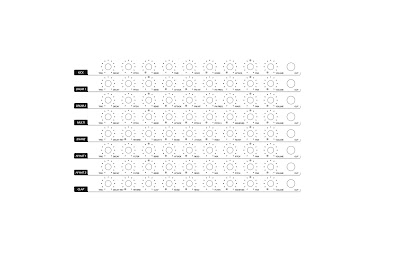
via
this auction
"Yamaha VL-1 physical modelling synth with the sought after version 2 firmware update. As Yammys go, it's a super rare peach of a thing and probably the best looking synth they made since the DX1. Even the floppies have faux mahogany stickers! VL's don't come up very often and VL-1's even less so.
[the following appears to have come from
enlightenedsystems.com]
New VL synths are equipped with the Version 2 firmware and voices, although Version 1 voice disks can be obtained and used. Beware, though, since a dealer may have a VL synth that sat on the shelf and has not been upgraded to Version 2. For those who own a Version 1 VL1, a very strong case can be made for upgrading to Version 2. To wit:

* Quite a few of the voices have been improved. Notable improvements have been made, for example, in the trumpet, ethnic guitar, tenor sax, and recorder voices. This involves improved voicing and new elements, not just parameter tweaks. A number of the more odious Version 1 elements no longer exist.
* The new Excitation model (decay from pulse excitation) can be used in editing, and the new ethnic guitar voices, for example, use it.

* The new Modulation Effects in Version 2 are Chorus, Phaser, Symphonic, Celeste, Distortion + Flanger, and Distortion + Wah. As with the Reverb effects, all of these effects are well done. The Chorus effect will find a lot of use, and I particularly like the Phaser, Symphonic, and Celeste effects. With the Phaser you can, for example, set the Feedback Gain and Wet/Dry Balance down from their wild levels to something in the range of 35% each to get an interesting evolving timbre change during held notes. The Distortion effects are probably aimed at the guitar voices, but could be used on others, if you like that sort of thing.
* New parameters and extended or finer-grained parameter settings are available in Version 2 on almost all editing screens.
* Version 2 allows keyboard splits with different elements for each hand. They have a dynamic way of implementing the split that follows your hand, without using a fixed split point.
* Ver 2 brings a bunch of new breath noise types that are easy to select to get just the right breath noise for your favorite voice. Note that these breath noises are not just attack chiff, but are modeled according to the actual sound of a real musical instrument, so they may show up during sustain or decay, they may vary with breath pressure, may combine with pitch components (e.g. sax, flute, clarinet), and so on. This is not chump chiff!
* The Mixing screen (the heart of the resonant model) has two new types of tap settings.
* 30 new microtunings have been added, including Scottish highland bagpipe tuning, various Arabic tunings, Phrygian, Thai, African, etc."

 via Escape from Noise where it is currently listed for sale.
via Escape from Noise where it is currently listed for sale.

 via Vermona
via Vermona

 via Tim Servo on electro-music.com
via Tim Servo on electro-music.com Even as an experienced builder, I learned some new tricks from this video. These DVDs are available directly from us at Magic Smoke, and we’re having an Introductory Special of $10 + shipping ($2.00 US/Canada, $4.00 EU/UK/Aus) for the first twenty customers. Write to us at
Even as an experienced builder, I learned some new tricks from this video. These DVDs are available directly from us at Magic Smoke, and we’re having an Introductory Special of $10 + shipping ($2.00 US/Canada, $4.00 EU/UK/Aus) for the first twenty customers. Write to us at











